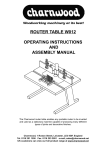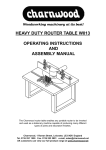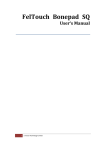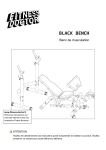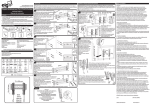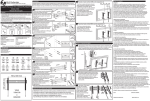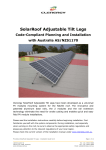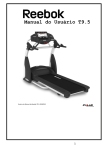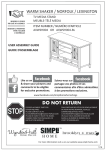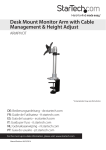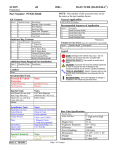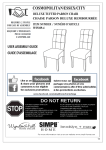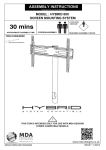Download ROUTER TABLE W012 OPERATING INSTRUCTIONS AND
Transcript
ROUTER TABLE W012 OPERATING INSTRUCTIONS AND ASSEMBLY MANUAL The Charnwood router table enables any portable router to be inverted and used as a stationary machine capable of producing many different types of joints and decorative finishes. Charnwood, 1 Rowan Street, Leicester, LE3 9GP, England Tel. 0116 251 1550 Fax. 0116 253 2891 e-mail; [email protected] UK customers can view our full product range at www.charnwood.net WARNING; When using electric tools, basic safety precautions should be followed to reduce risk of fire, electric shock, and personal injury, including the following: ASSEMBLY INSTRUCTIONS Part number are shown in brackets, for example (12) SAFETY INSTRUCTIONS 1) KEEP WORK AREA CLEAN - Cluttered areas and benches invite injuries. ASSEMBLE THE LEGS Attach the 2 Legs (3) to the Table (1) using 4 countersunk screws M8x55mm (6), Washers M8 (7), and Hex Nuts M8 (8). 2) CONSIDER WORK AREA ENVIRONMENT - Do not expose power tools to rain. Do not use power tools in damp or wet locations. Keep work area well lit. Do not use tools in the presence of flammable liquids or gases. 3) KEEP CHILDREN AWAY - All visitors should be kept away from work areas. 4) STORE IDLE TOOLS - When not in use, tools should be stored in dry, and high or locked-up places out of reach of children. 5) DO NOT FORCE THE TOOL - It will do the job better and safer at the rate for which it was intended. 6) USE THE RIGHT TOOL - Do not force small cutters to do the job of heavy duty cutters. Always use a cutter for its intended use only. Fig. 1 ASSEMBLE THE FENCE i) Locate the Fence Base (9), Wooden Fences (10), and Vertical Clamp Support (11). Insert a Countersunk Screw, M6x25mm (30), through the Wooden Fence then through the slot in the Fence Base and then through the Vertical Clamp Support. Secure with Washer M6 (16), and Female Knob M6 (13). 7) DRESS PROPERLY - Do not wear loose clothing or jewelry as they can be caught in moving parts. Wear protective hair covering to contain long hair. 8) USE SAFETY GLASSES - Also use face or dust mask when operations are dusty. A vacuum cleaner or dust extractor is strongly recommended. 9) SECURE THE TABLE - The router table should be bolted down or clamped to a sturdy bench. 10) DO NOT OVERREACH - Keep proper footing and balance at all times. Fig. 2 ii) Attach the two Vertical Clamps (12) to the Vertical Clamp Supports using Washer M5 (20) and Knob M5 (29). 11) MAINTAIN CUTTERS WITH CARE - Keep cutters sharp and clean for better and safer performance. 12) DISCONNECT ROUTER - When not in use and before changing or adjusting cutters. 13) CHECK DAMAGED PARTS - Always inspect cutters before use for signs of wear or damage. Do not use cracked or broken cutters. 14) STAY ALERT - Use common sense. Do not operate power tools when you are tired or under the influence of drugs, alcohol or medication. 15) TAKE EXTRA CARE WHEN SWITCHING Watch what you are doing when turning the router on and off. The NVR switch available as an optional item is recommended to avoid the operator having to reach under the table to operate the switch. Fig. 3 iii) Attach the Dust Chute Bracket (25) to the Fence Base using two Round Head Screws M5x6mm (19). Fit the Dust Chute Clamp (18) and secure with two Roundhead Screws M6x12mm (17), Washers M6 (21) and Hex Nuts M6 (22). Slide the Dust Chute (24) through the clamp and lock into place. Fig. 4 ROUTER MOUNTING INSTRUCTIONS i) MAKE SURE THE ROUTER IS UNPLUGGED. Remove the face plate cover from the router. ( If your router does not have a removable face plate cover, measure the spacing of the fixing holes in the face plate and then mark out the insert plate, keeping the cutter aperture as the centre.) Fig. 5 Fig. 8 ii) Remove the Insert Plate from the Router Table. iii) Align the centre of the cut-out in the insert plate with the centre of the cut-out in the face plate cover. Using the face plate cover as a template mark out the fixing holes. Fig. 6 iv) Attach the Guard (23) to the fence by inserting the bar into the square post and locking it into place with Knob M6x16mm (15). v) Fix the completed fence unit to the table by inserting Knob M6x16mm (15), with Washer M6 (16), through the slot in the Fence Base and into the threaded insert in the table. Fig. 7 Position 1 Position 2 There are two sets of threaded inserts in the table. The choice of which to use will depend on the type of job to be performed; Position 1 allows the fence to be set at the front of the cutter aperture when making shallow cuts. Position 2 allows the fence to be set further back from the cutter for operations such as trenching. ASSEMBLE THE FINGER PRESSURE Fit the Finger Pressure unit so that the Slot Guide (31) locates into the aluminium channel across the front of the table. The finger pressure is locked into position using the two plastic knobs (13). Fig. 9 The number and position of the holes will vary with each model of router. Use the larger diameter holes if there is a choice. A minimum of two fixings must be used, three or four fixings is preferable with heavier routers. A selection of fixing screws are included in this package which covers most common routers, but we cannot guarantee to cover every available model of router. In some instances it may be necesary to obtain alternative fixing screws. Fig. 10 iv) Drill and countersink the insert plate. Use a drill bit size suitable to the fixing screw you are going to use. If you do not have a countersink tool, drill the fixing hole and then make a countersink by partially drilling through with a larger diameter drill bit. Take care not to drill right through the insert plate. v) Leaving the face plate cover off (if removed) attach the insert plate to the router using the fixing screws supplied or alternative screws where required. Ensure the heads of the screws are slightly below the surface of the table. If they are not, it is necesary to drill the countersink slightly deeper. produced by the router manufacturer. Having set the cutter height fit the router back into the table and secure with the four screws. Fig. 11 vi) check that the router is secured tightly against the insert plate and that there is no movement between the two. vii) Install the desired cutter and set to the correct depth. Fit the router and insert plate into the table, securing with the four M6x16mm countersunk screws. Re-fit the fence and finger pressure. The Router Table is now ready for use. Fig. 12 PLEASE READ SAFETY INSTRUCTIONS BEFORE USE. BASIC OPERATING INSTRUCTIONS 1) EDGING AND PROFILING One of the most common operations undertaken using a router is Edging or Profiling, i.e. running a shaped cutter along the edge of the workpiece. In many instances this is for decorative purposes but it can also be to make a joint or fitting such as a raised panel. Using a router table for this type of work vastly reduces the setting up time required and does away with many awkward clamping devices. Router table users soon find that having both hands free to control the workpiece, rather than holding a machine, makes the task far more comfortable and generally a lot safer. SET THE CUTTER HEIGHT:- First fit a suitable cutter after making sure the router is unplugged. It is often easier to do this by unscrewing the insert plate from the table and lifting the router out of the table. Draw a profile of the required cut onto the edge of the workpiece and adjust the cutter height to match. Adjusting the cutter height is made much easier if a fine height adjuster is fitted to the router. With many models this now comes as standard, but on others it is available as an accessory SET THE FENCE:- The next step is to set the fence in a position to give the desired width of cut. Use the profile drawn on the end of the workpiece to set the fence and lock into position. There is an engraved scale along each end of the Insert Plate to assist in rapid fence setting. When using a cutter fitted with a guide bearing, the fence should be set in line or just in front of the edge of the bearing so that the workpiece runs on the face of the bearing. The distance between the two wooden fence faces can be adjusted by undoing the plastic knobs and sliding the fence face along with the top clamp along the slot in the fence bracket. The fence faces should be set so that the edges just clear the cutter. This provides the maximum amount of support to the workpiece during the cut. SET THE CLAMPS:- Adjust the Finger Pressure so that the distance between the ends of the fingers and the fence is between 1 to 4mm less than the width of the workpiece. This will hold the workpiece securely against the fence and prevent 'kick-back' during the cut. Next set the left and right Top Clamps. The curved pieces on the ends of the Top Clamp are made of flexible plastic and should be set so that the distance between the bottom of the clamp and the surface of the table is between 0 to 3mm less than the thickness of the workpiece. When the clamps are correctly set, the operator merely has to push the workpiece across the table. Please Note: Some workpieces may be too big to fit inside either the Top Clamps or the Finger Pressure, i.e. larger then 90x50mm. Simply remove the clamp/finger pressure from the table. The function of the clamps is twofold; to hold the workpiece securely against the cutter, whilst keeping the hands well away from it. When using larger workpieces the increased weight will help to keep it against the cutter and the danger of hands being too near the cutter is greatly reduced. SET THE CUTTER GUARD:- Adjust the perspex guard so that it just clears the work piece and will deflect any chips or dust which are thrown towards the operator. If possible connect a vacuum cleaner or dust extractor to the dust chute before commencing the cut. Make a cut with a waste piece of wood before using the workpiece. Mistakes cannot usually be rectified afterwards. THE GOLDEN RULES; ALWAYS KEEP HANDS WELL AWAY FROM THE CUTTER ALWAYS USE A PUSH STICK WITH SMALL WORKPIECES ALWAYS FEED FROM RIGHT TO LEFT ONLY 3) USING THE MITRE GUIDE For some operations it is not possible to use the fence as a guide, for example Trenching at an angle or cutting a Tenon where the width of the workpiece restricts good support from the fence. To do these jobs a sliding mitre guide is used which runs in the aluminium slot across the front of the table. REMOVE THE FENCE:- Undo the two fixing screws and either remove the fence or adjust it to a position were it will not ineterfere with the cut. Fig. 13 SET THE ANGLE:- To change the angle of the mitre fence, undo the knob and read off the engraved scale on the casting. Tighten the knob at the required angle. 2) GROOVING Grooving and Trenching operations are often carried out to form joints such as slot dovetails or to make fittings such as draw runner grooves. SET THE CUTTER HEIGHT:- Make sure the router is unplugged. Remove the router and Insert Plate from the table. Fit the appropriate cutter into the router and set the plunge depth to give the desired cut. Refit the router and insert plate into the router table and secure with the four screws. SET THE FENCE:- The cut is made away from the edge of the workpiece and therefore it will probably be necesary to move the Fence back into Position 2, see figure 7. Measure the distance between the edge of the workpiece and the start of the groove and lock the fence in position with the two plastic knobs. The two wooden fence faces should be closed up to form one continuous fence which will provide the best support. SET THE CLAMPS:- Set the Finger Pressure and Top Clamps as for edging and profiling. Remove the Top Clamps or Finger Pressure as necessary. CUTTER GUARD:- The cutter guard and dust extraction chute are not used during this operation. Get into the habit of testing all cutter or table adjustments on a waste piece of wood first before commencing on the workpiece. Fig. 15 4) CUTTING CURVES It is possible to put edge moulds on curved workpieces using a router table and a cutter with a bearing guide. Many cutters are now available with a bearing on top which is used as a guide instead of the fence. SET THE CUTTER HEIGHT:- Set the cutter height in the normal manner. You cannot take off a whole edge when using a bearing guided cutter. Making sure there is enough of the edge left uncut for the cutter bearing to run on. If the whole edge is to be removed or you wish to cut out a profile from a straight edge it is necessary to use a template. Attach the workpiece to the underside of the template so that once the cut is started the bearing will run on the edge of the template whilst the cutter touches only the workpiece. Fig. 14 W012 PARTS LIST Part No. Description Qty. 1 2 3 4 5 6 7 8 9 10 11 12 13 14 15 16 17 18 19 20 21 22 23 24 25 26 27 28 29 30 31 32 33 TABLE INSERT PLATE LEG RUBBER BUNG COUNTERSUNK SCREW M6x16mm COUNTERSUNK SCREW M8x55mm WASHER M8 HEX NUT M8 FENCE BASE WOODEN FENCE VERTICAL CLAMP SUPPORT VERTICAL CLAMP KNOB FEMALE M6 FINGER PRESSURE KNOB M6x16mm WASHER M6 (LARGE) ROUND HEAD SCREW M6x12mm DUST CHUTE CLAMP ROUND HEAD SCREW M5x6mm WASHER M5 WASHER M6 (SMALL) HEX NUT M6 GUARD DUST CHUTE DUST CHUTE BRACKET MITRE GUIDE RAIL MITRE GUIDE MITRE GUIDE FENCE KNOB M5x10mm COUNTERSUNK SCREW M6x25mm SLOT GUIDE NOTCHED SCREW M6x30mm PACK OF FIXING SCREWS M4x15mm M5x15mm M6x15mm 1 1 2 8 4 4 4 4 1 2 2 2 4 1 4 7 2 1 2 4 2 2 1 1 1 1 1 1 2 2 1 2 3 4 4 Optional Items NVR SWITCH W025 An excellent safety device, the switch is used instead of the routers on/off switch and avoids the user having to reach under the table when the router is running.








